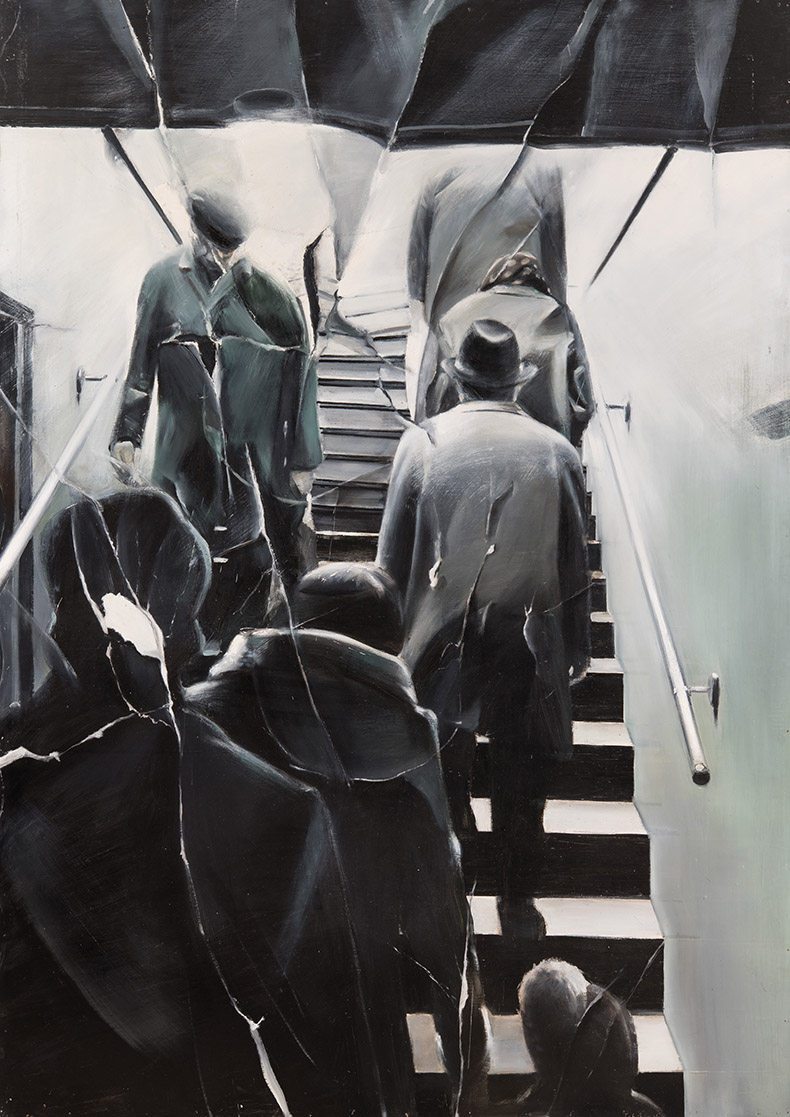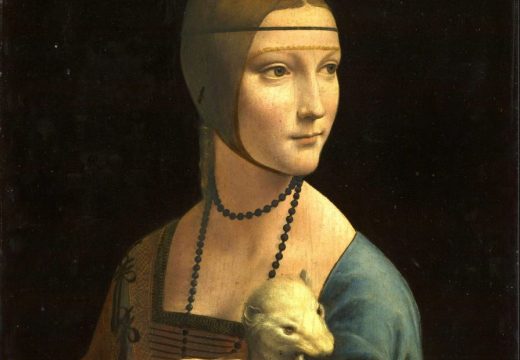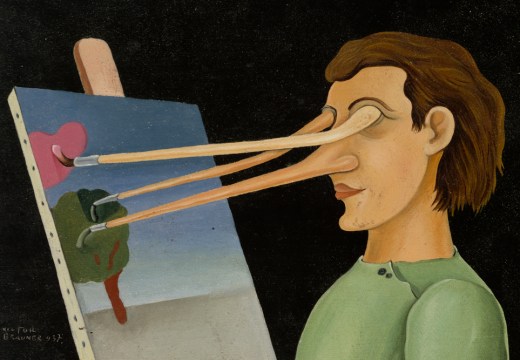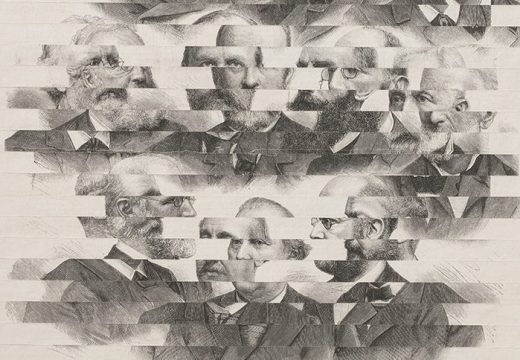From the February 2024 issue of Apollo. Preview and subscribe here.
‘Multiple Realities: Experimental Art in the Eastern Bloc, 1960s–1980s’ opens with a crumpled black-and-white photograph – more precisely, with a painting of one. Aluljaro I (Underground Passage I) from 1975 by the Hungarian artist Laszlo Feher is part of a series of photorealist renderings of passengers descending to or emerging from the Budapest underground, captured at oblique angles more suggestive of spying than portraiture. It is a fitting start to an exhibition in which almost nothing is exactly as it seems. As the title suggests, artists working in the Soviet satellite states experienced reality as something volatile and unfixed, as they moved between the spheres of a bureaucratic officialdom – the rules of which could change in an instant – and the spaces of relative freedom they managed to carve out within it.
More literally, ‘multiple realities’ aptly characterises the region in this period: what was possible in Poland or Yugoslavia was not necessarily possible in Romania or East Germany. Conditions varied widely not only from country to country, but also year to year: in the mid 1960s, Prague was among the most permissive cities in the Bloc, evident in public actions such as The Aktual Walk – Demonstration for All Senses (1964), a Fluxus-inspired Happening by Milan Knizak; after the brutal repression of the Prague Spring in 1968, experimental art was forced underground. Accordingly, curator Pavel Pys dispenses with chronology, dividing the show into four thematic sections supplemented by ‘content rooms’ providing context in the form of archival images and text panels.

Aluljaro I. (Underground Passage I.) (1975), Laszlo Feher. Kiscelli Muzeum, Budapest. Courtesy and © the artist
The first section, ‘Public and Private Spaces of Control’, explores the effects of mass state surveillance upon artists, many of whom appropriated its forms and techniques to comment on its total mediation of everyday life. Throughout the 1970s, Czech artist Jiri Kovanda performed nearly invisible actions in public space – for instance, turning around to stare at the person behind him on an escalator – displayed as a series of typewritten reports accompanied by photographs taken from a distance by an accomplice. Ion Grigorescu’s photo series Electoral Meeting (1975), taken with a concealed camera, documents undercover agents of the Romanian Securitate conspicuously monitoring the crowd at a Party rally.
By contrast, the ‘Dimensions of the Self’ section turns from the scrutiny of the public sphere to the intimacy of bodily sensation, with an emphasis on explorations of gender and sexuality by women and queer artists, including a display of exquisite sculptures abstracting the female form by Maria Pininska-Beres, Eva Kmentova, Alina Szapocznikow, and Barbara Falender. A number of the works take the form of private performances staged for a small audience of trusted friends – or, in some cases, exclusively for the camera – which reached a wider public only after the fall of the Wall. There are several grids of staged photographs by the East German artists Cornelia Schleime and Gabriele Stötzer, friends and frequent collaborators in the 1980s who often posed for one another in eccentric or confining costumes. Collaboration outside of the enforced norms of state collectivity is also the subject of the ‘Being Together’ section. It ranges from riotous countercultural artefacts such as Andrzej Urbanowicz’s double-sided painting Jezioro Ducha (‘Spirit Lake’) from 1970, made under the influence of LSD and the Rolling Stones, to Julius Koller’s sprawling participatory artwork J.K. Ping-Pong Club, begun in Bratislava in 1970 and continued until the artist’s death in 2007.
As the exhibition makes clear, however, the borders between state-sanctioned culture and the experimental underground were never quite so neatly drawn, demonstrated with particular effectiveness by two bodies of work that ostensibly represented opposite poles of artistic expression in East Germany: a group of linocuts depicting strapping young worker-athletes from Jürgen Wittdorf’s Jugend und Sport series of 1964, made for the Academy of Sport in Leipzig, and Stötzer’s Trans Sitzend (1983–84), an array of photographs capturing a young man posing in drag. Yet in the former, Wittdorf, a closeted Party artist, smuggles a remarkably unsubtle homoeroticism into a widely reproduced state commission – under the cover of celebrating heroic proletarian masculinity – while Stötzer’s nonconformist subject was, she learnt years later, a Stasi informer tasked with infiltrating her circle. Likewise, the final ‘Looking to Other Futures’ section is devoted to experiments with new media, made within state institutions such as the Polish Radio Experimental Studio, where artists could use their access to the latest advancements in computer engineering and telecommunications for decidedly personal ends.
Though obviously the product of prodigious research – the catalogue is a doorstopper – ‘Multiple Realities’ is very much a curator’s exhibition. The prioritising of thematic cohesiveness over comprehensiveness in the galleries has its advantages: the works are beautifully installed, the transitions from one section to the next particularly thoughtful. Pys’s thematic approach also allows for several welcome surprises, such as a reconstruction of Gyula Konkoly’s Bleeding Monument (1969) – a block of ice in the shape of a torso, coated in the disinfectant potassium permanganate and wrapped in gauze, which slowly melts, leaving the impression of a bleeding body – and Miejsca (‘Places’) of 1975, an eerily alluring tapestry installation by Janina Tworek-Pierzgalska that disperses representations of bodily fragments around a room like furniture.
However, for an exhibition that advertises itself as the largest survey of East-Central European art to date, there are egregious omissions. KwieKulik, Tamas Szentjoby, Laibach and Mladen Stilinovic are just a few of the major figures who are altogether absent from the galleries. The more austere forms of analytical conceptual art and mail art that were pervasive across the region are largely relegated to a single content room about international cooperation and exchange. (By contrast, certain artists whose works conform more neatly to the exhibition’s themes are arguably overrepresented, namely Stöltzer and Schleime, who appear in almost every section.) But if the show offers an incomplete overview of the experimental art that flourished under state socialism, it nevertheless captures the spirit of the era’s ‘second public sphere’ in all its radical contradictions.
‘Multiple Realities: Experimental Art in the Eastern Bloc, 1960s–80s’ is at the Walker Art Center, Minneapolis, until 10 March.
From the February 2024 issue of Apollo. Preview and subscribe here.
Unlimited access from just $16 every 3 months
Subscribe to get unlimited and exclusive access to the top art stories, interviews and exhibition reviews.














![Masterpiece [Re]discovery 2022. Photo: Ben Fisher Photography, courtesy of Masterpiece London](http://www.apollo-magazine.com/wp-content/uploads/2022/07/MPL2022_4263.jpg)
It’s time for the government of London to return to its rightful home